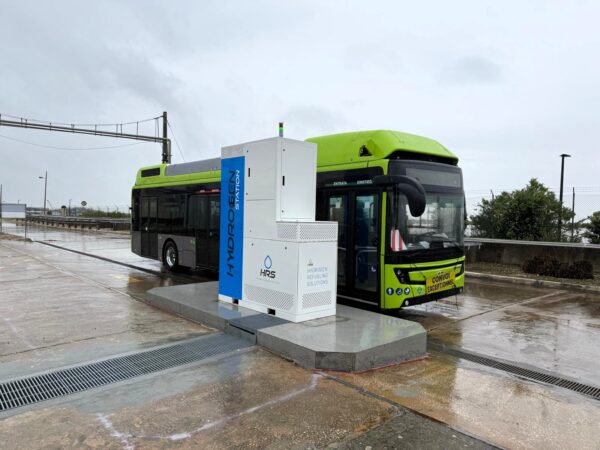Hydrogen: the energy of the regions
HRS hydrogen refueling stations represent a concrete solution enabling a large-scale reduction of greenhouse gas emissions and the achievement of carbon neutrality within regional authorities. Our stations play a key role in the development of low-carbon mobility across the regions.
Why choose hydrogen mobility for your regional authority?
By 2026, public sector stakeholders will need to have upgraded their fleets to include at least 37.4% "very low-emission" vehicles1, i.e. battery electric or hydrogen vehicles.1, c’est-à-dire électriques à batterie ou hydrogène.
Where range, refueling time and loading capacity requirements dictate, hydrogen is proving the most suitable mobility solution.
At a regional level, the use of hydrogen must be linked to local dispensing infrastructure. HRS will support you in developing an ecosystem through a turnkey dispensing system similar to that used for gas stations. A great way to bring together and mobilise both public and private stakeholders.
Regional authorities can therefore deploy the use of hydrogen in a wide range of transport applications suitable for their particular authority: buses, waste collection trucks, tractors, heavy goods vehicles, refrigerated trailers, cargo bikes, commercial vehicles; rail mobility: regional or inter-regional trains travelling on non-electrified lines; sea and river mobility: boats, shuttles and pushers, etc.
1 ADEME
Combined use by public and private stakeholders for mobility
Regional authorities, in association with economic stakeholders, are gradually creating regional networks with public hydrogen dispensing stations for varied use by regional authorities, businesses, the public, etc.
HRS has a presence across the French regions:
- Auvergne Rhône Alpes: H2 station in Saint-Priest
- Vendée: H2 station in La Roche-sur-Yon | H2 station in Les Sables-d’Olonne
- Brittany: H2 station in Vannes
- Hauts de France: H2 station in Dunkerque
A fleet of hydrogen vehicles for public services
Waste collection trucks, buses, commercial vehicles… will prove effective in hydrogen versions. These vehicles offer comfortable operation on journeys exceeding 100 km and double collections with reduced interval times.
Installing a hydrogen refueling station in your municipality will enable you to refuel your vehicle fleet in one of two ways:
- rapidly through operation similar to that of a service station (15 minutes for a 30 kg bus tank, for example)
- slow refueling of several vehicles simultaneously on site.
Do you represent a regional authority with a hydrogen mobility project?
The HRS teams will support you by offering you the optimal solution for your needs. Contact our experts.
Feedback from SYDEV
Since 2022, HRS has been working closely with SYDEV and has delivered two HRS14 to La Roche-sur-Yon and Les Sables-d’Olonne. In the article “First deployments of hydrogen electric buses in France: feedback” from France Hydrogène, SYDEV shares its feedback with HRS on its station in La Roche sur Yon:
"The excellent availability of HRS technicians has ensured that the infrastructure is available on time and meets the needs. Since it was put into service, the station has been operating very well and no specific difficulties have been encountered."
SYDEV also considers that "the station's availability rate exceeding 96% is very satisfactory, and higher than the objective set when the contract with HRS was established. This trend continues to improve, and no major hazards are to be deplored."
All this is possible thanks to the teams deployed to take care of the maintenance of the stations, whether remotely or by traveling with our local teams directly on site to resolve the problem.
SYDEV concludes: "The level of reliability today is such that incidents are infrequent, and the procedures in place make it possible to maintain operation without impact on users."
H2 Mobility Focus
In several French cities and metropolises, collective mobility fleets are converting to hydrogen!
For buses and coaches coming to be refueled at Sydev stations in la Roche-sur-Yon and Sables d’Olonne, hydrogen is an opportunity for:
- A great autonomy for these vehicles that stop regularly,
- A fast refueling in 350 and 700 bar in 20 minutes maximum,
- The possibility of accelerating efficiently on slopes and in hilly areas,
- Comfort for all thanks to the reduction of odors, noise and vibrations.
1000km range for this hydrogen coach!
Passing through Saint-Sulpice, the Irizar coach refueled with hydrogen in less than 20 minutes at the HRS40 station for Seven on its way from San Sebastian to Marseille.
This refueling enabled it to keep its promises:
- 52 kg of hydrogen on board
- 1000 km range
- 57 passengers on board
- Zero emissions
France Hydrogen's forecasts
Number of buses
Number of BOM
Number of coaches
Advantages of hydrogen for collective mobility

Reduced environmental footprint
Hydrogen vehicles produce electricity by combining H2 and O2, and emit only water vapour. No CO2 is emitted during this process.

Reliability and safety
Our stations are manufactured on an industrial scale. Our dispensers comply with fueling protocol SAE J2601/ISO 19880-1 T30 and are confirmed by the CEP (Clean Energy Partnership)

No need to change old habits!
To refuel, simply connect the pump to your vehicle. The refueling time is the same as that for combustion engine vehicles.

An ecosystem to accelerate the transition
Installing a station within a region provides access to a refueling station for widespread use and helps drive the transition to low-carbon mobility.

Long range
Drive several hundred kilometres with full autonomy to ensure your continuity of service. The range of H2 vehicles is identical to that of combustion engine vehicles.

Reducing noise pollution
Hydrogen powered vehicles are very quiet for significantly lower noise pollution from your activities.

Fast recharging
Hydrogen refueling reduces vehicle standstill times. The fueling protocol enables fast refueling of heavy-duty vehicles: ~15 minutes for a 30 kg tank.








